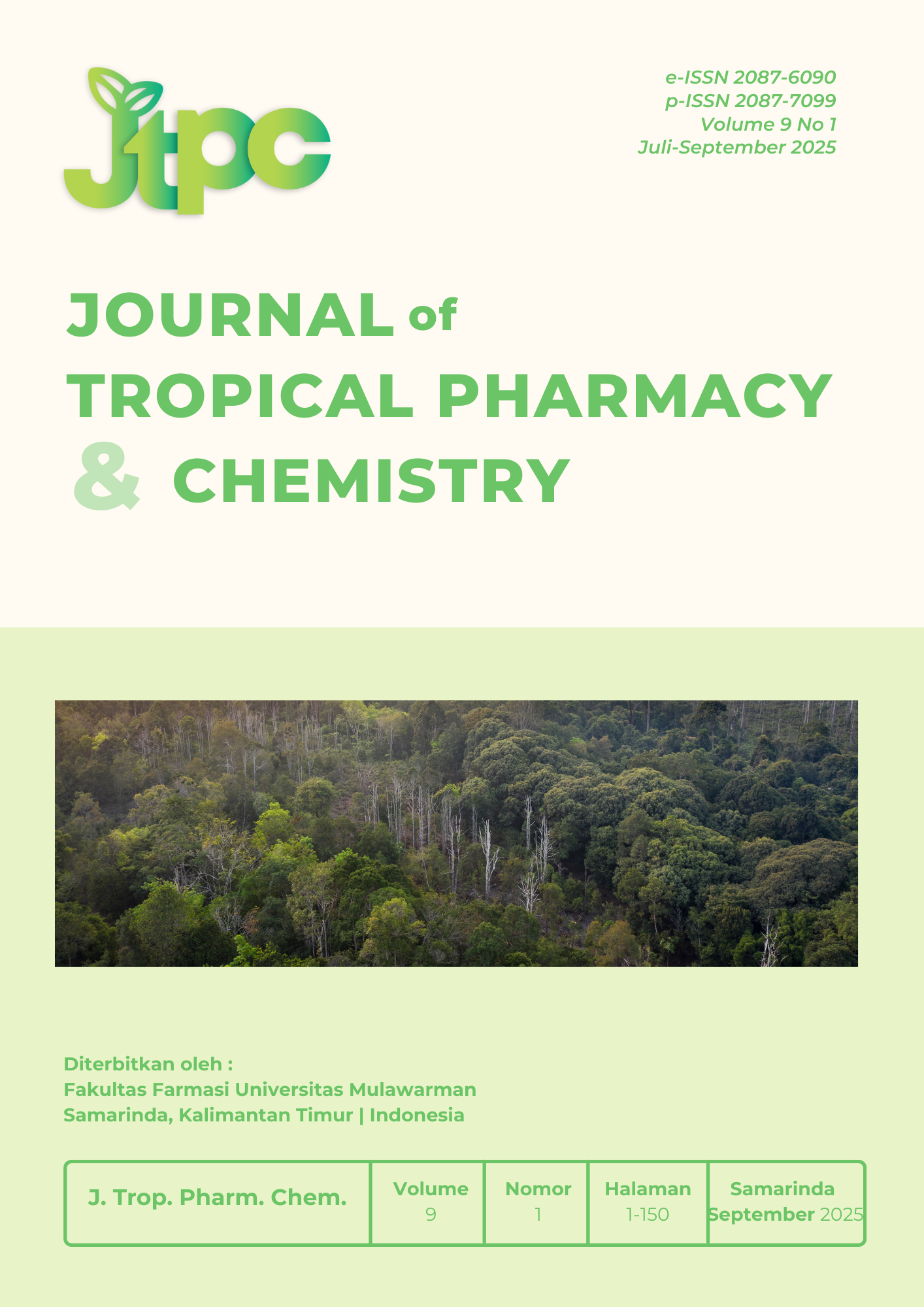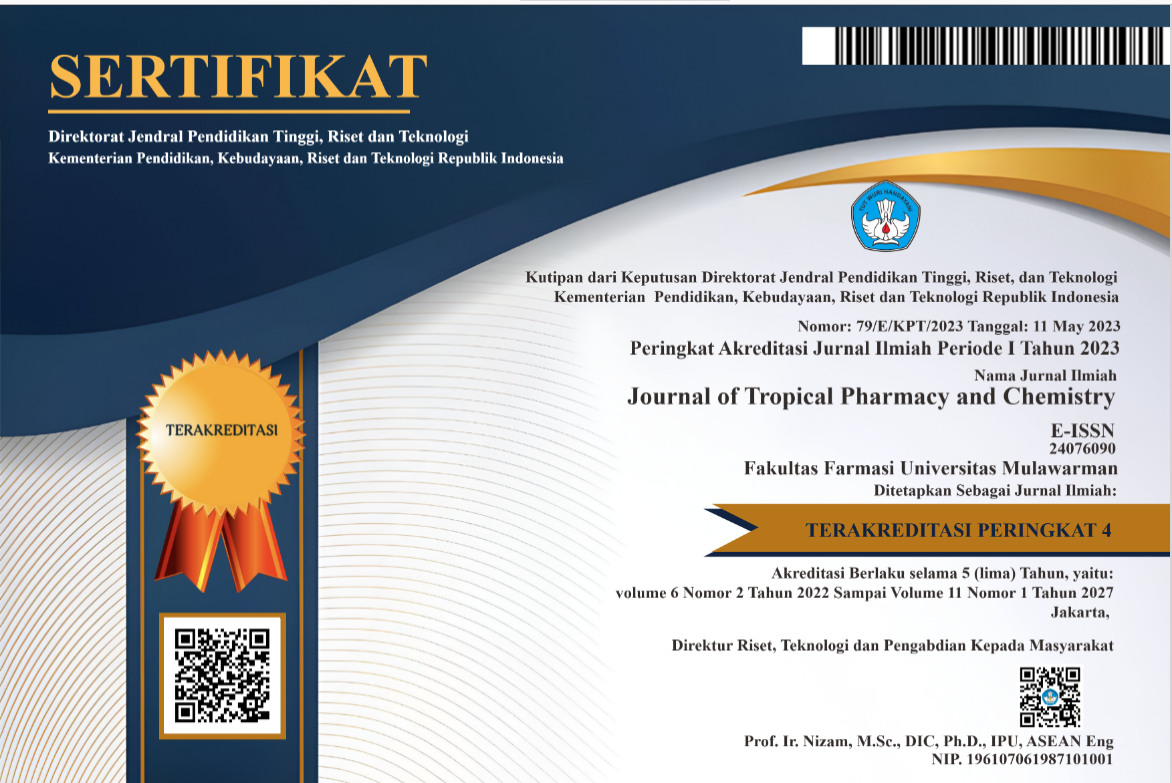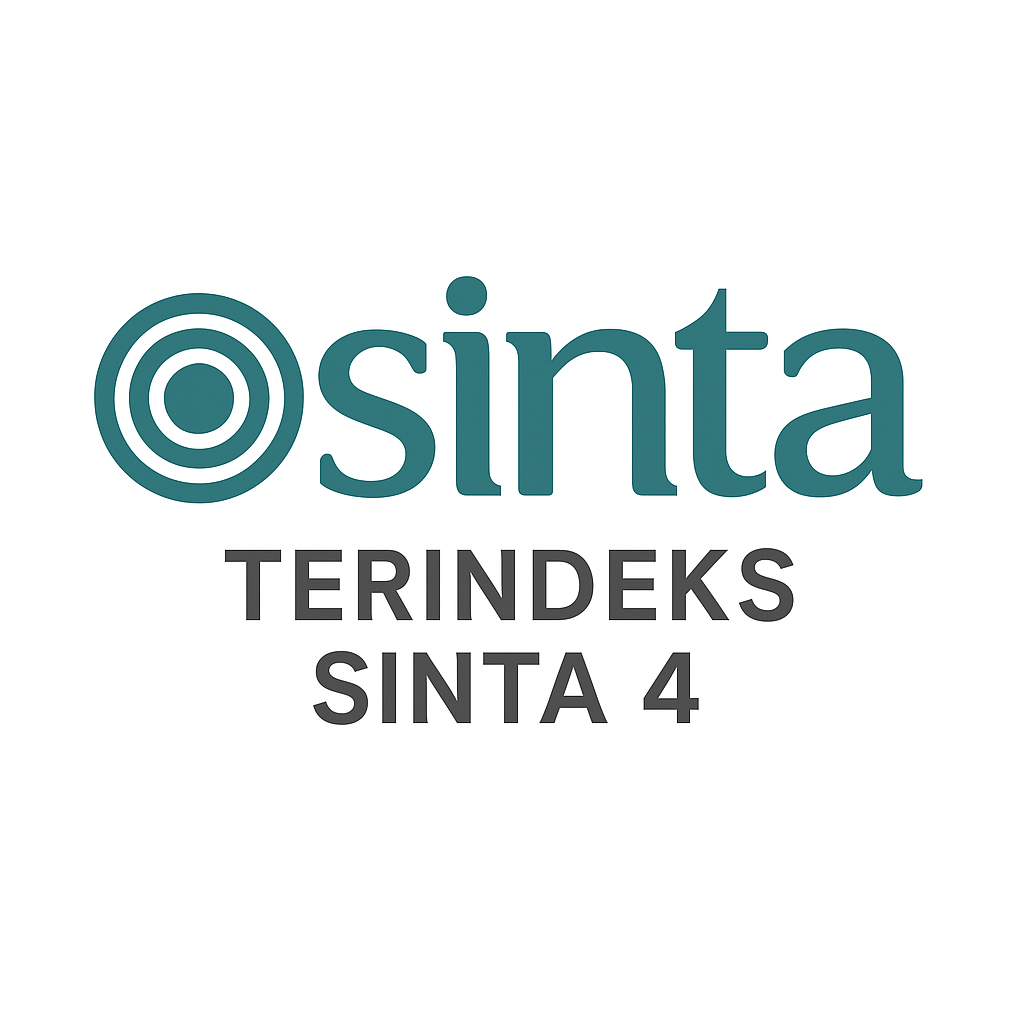Prediction and ADMET of Bioactive Gingerol from Red Ginger Plant (Zingiber officinale var. Rubrum)
DOI:
https://doi.org/10.30872/jtpc.vi.296Keywords:
PASS Online, pkCSM, pharmacological prediction, ADMET analysis, Zingiber officinale var. RubrumAbstract
The present study focuses on the predictive analysis of pharmacological activity and ADMET (Absorption, Distribution, Metabolism, Excretion, and Toxicity) profiles of a selected bioactive compound using advanced in silico tools, PASS Online and pkCSM. The pharmacological potential was assessed through the Pa (probability of activity) and Pi (probability of inactivity) values, revealing strong activity predictions such as serotonin release stimulation, linoleate diol synthase inhibition, and UDP-glucuronosyltransferase substrate potential. These results suggest multiple biological interactions and diverse therapeutic possibilities. Furthermore, the ADMET evaluation highlighted favorable pharmacokinetic behavior, including good intestinal absorption (92.416%), moderate water solubility (-3.164 log mol/L), and non-substrate characteristics toward P-glycoprotein inhibitors. The compound exhibited safe toxicity parameters, being non-mutagenic in the AMES test, non-hepatotoxic, and showing low hERG inhibition potential, which indicates minimal cardiotoxic risk. Moreover, its moderate volume of distribution (0.524 log L/kg) and high clearance (1.339 log ml/min/kg) demonstrate effective systemic disposition. The combined PASS and pkCSM predictions indicate that the compound possesses a promising pharmacological profile, suitable absorption characteristics, favorable metabolism, and low toxicity risks, supporting its potential for further experimental validation as a therapeutic candidate.
Downloads
References
[1] R. F. A. A. Lestaluhu, A. R. T. P. Astuti, and S. Wahjuni, "Study In Silico of Gingerol and Shogaol from Red Ginger Rhizome (Zingiber Officinale var. rubrum) as Anti-Inflamatory," J. Surya Med., vol. 9, no. 2, pp. 248–254, 2024.
[2] H. H. Al-Shammari, M. A. Al-Akhras, B. Odat, and V. Narayanaswamy, "Molecular Simulations of 6-Gingerol Loading on Graphene and Graphene Oxide for Drug Delivery Applications," Biointerface Res. Appl. Chem., vol. 13, no. 3, p. 258, Jun. 2023. DOI: 10.33263/BRIAC133.258.
[3] M. I. U. Haq et al., "Pharmacokinetic, toxicological, and molecular interaction assessment of ginger-derived phenolics for SARS-CoV-2 main protease Inhibition," Sci. Rep., vol. 15, no. 1, Jul. 2025.
[4] S. A. P. Lestari, A. N. Artanti, and I. D. K. Arisanti, "Potential of Red Ginger Rhizome (Zingiber officinale Roscoe var. Rubrum) as an Anti-Cancer: A Review," Pharmacol. Clin. Pharm. Res., vol. 7, no. 1, pp. 1–9, 2024.
[5] A. B. H. Z. Abidin, "In Silico Target Prediction of 6-Gingerol and Similar Compounds as Potential Anticancer Agents," FABAD J. Pharm. Sci., vol. 49, no. 1, pp. 1–18, 2024.
[6] M. F. Ramadhan et al., "Gingerols and Shogaols of Zingiber officinale var. sunti Valeton as Potential Allosteric Agonists of Human GABAA Receptor by in silico Pharmacology Approach," Mol. Divers., Jun. 2025.
[7] A. P. Singh et al., "Structure based docking and biological evaluation towards exploring potential anti-cancerous and apoptotic activity of 6-Gingerol against human prostate carcinoma cells," J. Biomol. Struct. Dyn., vol. 42, no. 1, pp. 245–257, Jan. 2024.
[8] D. K. Yadav et al., "Anti-Inflammatory Therapeutic Potential of 6,8,10-Gingerols Against Cox Pathway by Molecular Docking Analysis," Preprints.org, 202503.2176, Mar. 2025.
[9] H. M. Algarni et al., "Mechanism exploration of 6-Gingerol in the treatment of atherosclerosis based on network pharmacology, molecular docking and experimental validation," Phytomedicine, vol. 114, p. 154784, May 2023.
[10] S. A. Shinde, M. J. Mhetar, A. G. Parit, and A. R. Thombre, "In-silico Investigation and ADMET Prediction of Potential Antifungal Phytochemicals against Lanosterol 14-Alpha Demethylase Inhibitors," Asian J. Pharm. Res., vol. 14, no. 1, pp. 5–10, 2024.
[11] M. Z. Muttakin, "Studi in silico senyawa kandungan jahe merah (zingiber officinale var. rubrum) sebagai antivirus SARS CoV-2 terhadap reseptor nucleocapsid (6VYO) dan main protease (6M2N)," Undergraduate thesis, Univ. Islam Negeri Maulana Malik Ibrahim, Malang, Indonesia, 2023.
[12] H. Hefni, F. R. M. Rivai, and A. S. Az-zahra, "Activity of Red Ginger Extract (Zingiber officinale var. Rubrum) Against Interleukin-6," Int. J. Appl. Pharm., vol. 15, Special Issue 1, pp. 21–23, 2023.
[13] M. Kusdiharti et al., "The Anti-Inflammatory Potential of Fermented Red Ginger Extract (Zingiber officinale var. Rubrum) Against In Vitro Protein Denaturation," J. Skala Husada, vol. 21, no. 1, pp. 58-64, 2024.
[14] M. B. E. A. El-Kafrawy et al., "Network pharmacology, molecular docking, and dynamics analyses to predict the antiviral activityof ginger constituents against coronavirus infection," Front. Pharmacol., vol. 15, p. 1365430, 2024.
[15] A. G. O. A. M. H. El-Din et al., "6-Gingerol, a Bioactive Compound of Zingiber officinale, Ameliorates High-Fat High-Fructose Diet-Induced Non-Alcoholic Related Fatty Liver Disease in Rats," J. Exp. Pharmacol., vol. 16, pp. 455–466, Dec. 2024.
[16] M. Ishfaq, W. Hu, Z. Hu, Y. Guan, dan R. Zhang, “A review of nutritional implications of bioactive compounds of Ginger (Zingiber officinale Roscoe), their biological activities and nano-formulations,” Italian J. Food Sci., vol. 34, no. 3, pp. 1–12, Jul. 2022. doi: 10.15586/ijfs.v34i3.2212.
[17] S. Zhang, E. DiMango, Y. Zhu, T. K. Saroya, C. W. Emala, dan S. Sang, “Pharmacokinetics of Gingerols, Shogaols, and Their Metabolites in Asthma Patients,” J. Agric. Food Chem., vol. 70, no. 31, pp. 9674–9683, Aug. 2022. doi: 10.1021/acs.jafc.2c03150.
[18] T. Sulastri dan M. R. Suwitono, “Quantification of 10-Gingerol Content in Various Encapsulation of Red Ginger Extract Using HPLC Method,” 8ISC Proc.: Sci., pp. 37–40, Feb. 2022.
[19] N. Pratiwi, C. Utami Wirawati, dan D. Eva Nirmagustina, “Red Ginger oleoresin nanoemulsion characteristics by ultrasonication,” J. Nat. Scien. & Math. Res., vol. 8, no. 2, pp. 59–65, 2022.
[20] A. G. Dilukshi Vichakshana, S. C. Foo, dan W. S. Choo, “Evaluation of high-pressure homogenization as a pretreatment for the extraction and drying of 6-gingerol from ginger,” Sustain. Food Technol., vol. 2, pp. 760–768, Apr. 2024. doi: 10.1039/d3fb00245d.
[21] M. K. Samota, M. Rawat, M. Kaur, dan D. Garg, “Gingerol: extraction methods, health implications, bioavailability and signaling pathways,” Sustain. Food Technol., vol. 2, pp. 1652–1669, Sep. 2024. doi: 10.1039/D4FB00135D.
[22] M. E. Preciado-Ortiz, E. Martínez-López, J. Pedraza-Chaverri, O. N. Medina-Campos, R. Rodríguez-Echevarría, S. D. Reyes-Pérez, dan J. J. Rivera-Valdés, “10-Gingerol Increases Antioxidant Enzymes and Attenuates Lipopolysaccharide-Induced Inflammation by Modulating Adipokines in 3T3-L1 Adipocytes,” Antioxidants, vol. 13, no. 9, p. 1093, 2024. doi: 10.3390/antiox13091093.
[23] “A critical review of Ginger’s (Zingiber officinale) antioxidant, anti-inflammatory, and immunomodulatory activities,” Front. Nutr., vol. 11, p. 1364836, Jun. 2024. doi: 10.3389/fnut.2024.1364836.
[24] M. Gonzalez-Gonzalez et al., “Determination of Gingerols and Shogaols Content from Ginger (Zingiber officinale Rosc.) through Microwave-Assisted Extraction,” Agronomy, vol. 13, no. 9, p. 2288, 2023. doi: 10.3390/agronomy13092288.
Downloads
Published
Issue
Section
License
Copyright (c) 2025 Yuneka Saristiana, Fendy Prasetyawan, Novyananda Salmasfattah, Lisa Savitri (Author)

This work is licensed under a Creative Commons Attribution-NonCommercial 4.0 International License.




